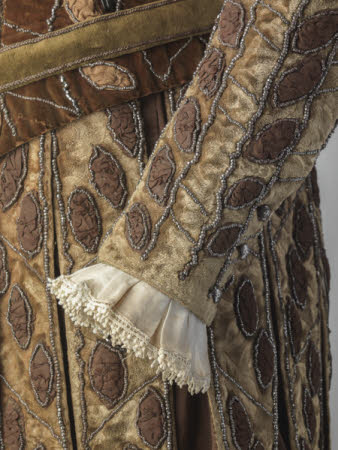Costume worn by Henry Irving (1838 –1905) in the role of 'Benedick' in the 1882 production of 'Much Ado About Nothing'
Auguste et Cie
Category
Costume
Date
1882
Materials
velvet, silk, ribbon, steel cut beads
Place of origin
London
Order this imageCollection
Smallhythe Place, Kent
NT 1118907.1
Summary
Doublet, part of the costume worn by Henry Irving (1838 –1905) in the role of 'Benedick' in the 1882 production of 'Much Ado About Nothing' at the Lyceym Theatre. Doublet is of light brown figured velvet, with mock slashing of petersham ribbon edged with steel cut beads.
Full description
Actor-Manager Henry Irving (1838–1905) staged 'Much Ado About Nothing' at the Lyceum Theatre in 1882 playing opposite Ellen Terry (1847–1928). Terry and Irving were the leading Shakespearian actors of their day and insisted on staging plays informed by the authenticity of Shakespeare’s original text rather than merely adhering to previous characterisations. Irving's Benedick was therefore a gentleman rather than a bully while Terry's Beatrice was the ‘merry hearted, pleasant spirited lady’ rather than the scold of traditional interpretation. The same principle was applied to the staging and costume design. Working with theatre manager (and 'Dracula' author), Bram Stoker (1847-1912), Irving’s sets for the play were among the most lavish and meticulous ever produced. The most opulent staging was for the famous wedding scene of Claudio and Hero, where chaos ensues after Hero is accused of being unfaithful. Irving used an Italian picture of a cathedral for the backdrop and consulted a priest over the liturgical accuracy of the altar and lights. The intricately detailed costumes worn by Irving and Terry in 'Much Ado About Nothing' show the influence of Elizabethan fashion(NT 1118832; NT1118835; NT 1118907). They were produced by theatrical costumiers Auguste et Cie, based in the heart of London’s theatreland off The Strand, they supplied theatres across Britain and America and the costumier Patience Harris, whose mother founded the company in 1873, is likely to have overseen the design process. Heavily structured and made of thick velvet, the costumes would have been hot and restrictive to wear. But what they lacked in comfort was offset by their impact; the bold green and red foliate pattern of Beatrice’s dress was inspired by 16th-century Italian velvet designs and the beading on the front of Benedick’s doublet would have shimmered under the soft intensity of the theatre’s limelight. 'Much Ado About Nothing' opened on 11 October 1882 to enthusiastic reviews. The response and sentiment of the audience was captured in a review in the Daily Telegraph: ‘There was but one remark heard last night as an audience, with pleasure written on every countenance, filed out of the handsome theatre into the wet and miserable streets. All had gone more than well...and never before in the memory of the oldest playgoer, had "Much Ado About Nothing" been so well acted or so sumptuously attired.'
Makers and roles
Auguste et Cie , costumier Patience Harris, designer


